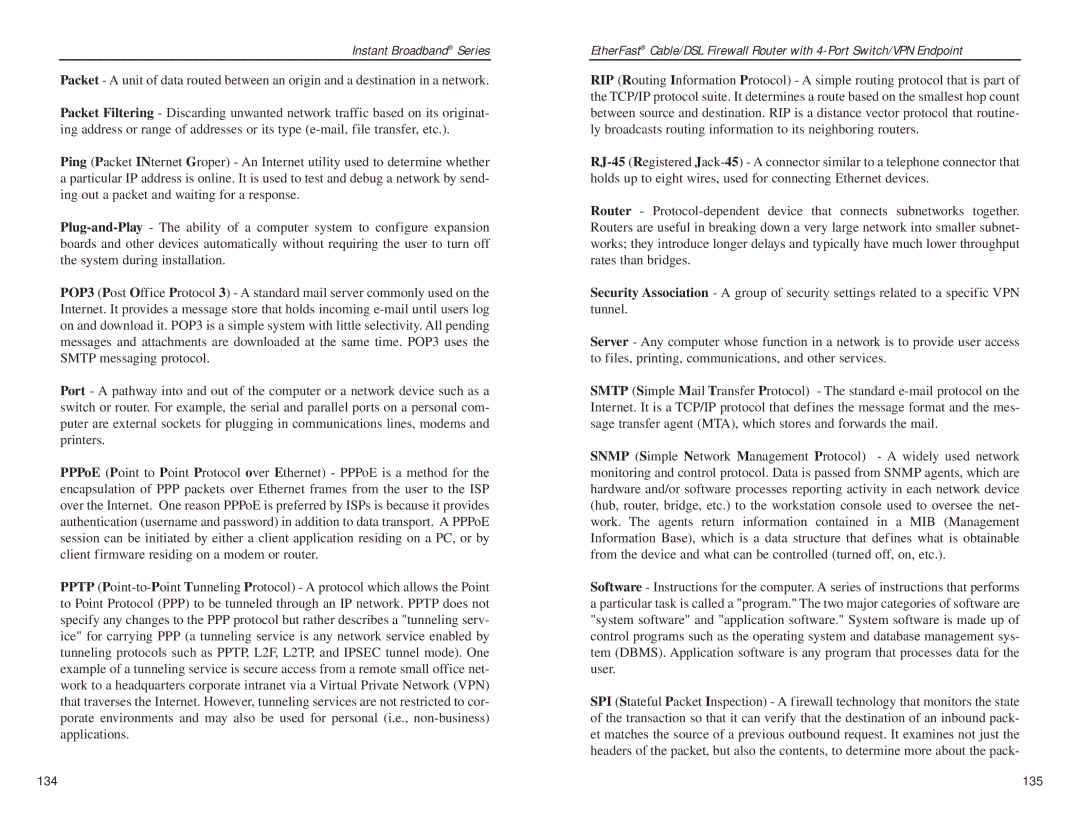Instant Broadband® Series
Packet - A unit of data routed between an origin and a destination in a network.
Packet Filtering - Discarding unwanted network traffic based on its originat- ing address or range of addresses or its type
Ping (Packet INternet Groper) - An Internet utility used to determine whether a particular IP address is online. It is used to test and debug a network by send- ing out a packet and waiting for a response.
POP3 (Post Office Protocol 3) - A standard mail server commonly used on the Internet. It provides a message store that holds incoming
Port - A pathway into and out of the computer or a network device such as a switch or router. For example, the serial and parallel ports on a personal com- puter are external sockets for plugging in communications lines, modems and printers.
PPPoE (Point to Point Protocol over Ethernet) - PPPoE is a method for the encapsulation of PPP packets over Ethernet frames from the user to the ISP over the Internet. One reason PPPoE is preferred by ISPs is because it provides authentication (username and password) in addition to data transport. A PPPoE session can be initiated by either a client application residing on a PC, or by client firmware residing on a modem or router.
PPTP
EtherFast® Cable/DSL Firewall Router with
RIP (Routing Information Protocol) - A simple routing protocol that is part of the TCP/IP protocol suite. It determines a route based on the smallest hop count between source and destination. RIP is a distance vector protocol that routine- ly broadcasts routing information to its neighboring routers.
Router -
Security Association - A group of security settings related to a specific VPN tunnel.
Server - Any computer whose function in a network is to provide user access to files, printing, communications, and other services.
SMTP (Simple Mail Transfer Protocol) - The standard
SNMP (Simple Network Management Protocol) - A widely used network monitoring and control protocol. Data is passed from SNMP agents, which are hardware and/or software processes reporting activity in each network device (hub, router, bridge, etc.) to the workstation console used to oversee the net- work. The agents return information contained in a MIB (Management Information Base), which is a data structure that defines what is obtainable from the device and what can be controlled (turned off, on, etc.).
Software - Instructions for the computer. A series of instructions that performs a particular task is called a "program." The two major categories of software are "system software" and "application software." System software is made up of control programs such as the operating system and database management sys- tem (DBMS). Application software is any program that processes data for the user.
SPI (Stateful Packet Inspection) - A firewall technology that monitors the state of the transaction so that it can verify that the destination of an inbound pack- et matches the source of a previous outbound request. It examines not just the headers of the packet, but also the contents, to determine more about the pack-
134 | 135 |
